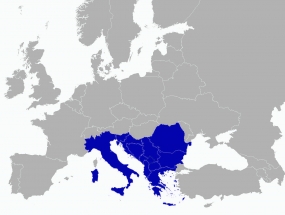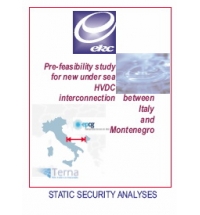Feasibility study for new under sea HVDC interconnection between Italy and Montenegro
client: EBRD, Terna (Italy), EPCG (Montenegro)
type: Regional Study (Transmission, Power Quality, Market)
finishing date: a) March 2008; b) July 2008
team:
a) M.Vukovic, S. Mijailovic, P. Miksa, Z. Vujasinovic, S. Markovic, T. Martinovic, N. Jovic
b) M.Vukovic, S. Agarwal, M. Papic, Dj. Dobrijevic, P. Miksa, N. Krajisnik, S. Markovic, T.Martinovic, N. Jovic
a) Static security analyses
b) Economical and financial aspects, Short Circuit, Voltage and Dynamic Stability analyses
In light of energy situation in Europe and definite differentiation of exporting and importing countries in exporting and importing regions, the need for new interconnection lines for transferring power has emerged. One such interconnection is taken into consideration and it is supposed to connect region of SEE and Italy with HVDC submarine cable of 1000 MW transfer capacity. Connection points will be Italy (Foggia) and Montenegro (Tivat).
The scope of the study is to review current and future development stages of transmission network in SEE, and to evaluate feasibility of new under sea HVDC interconnection between Italy and Montenegro for 2016. Product of the analysis provides a possible set of new transmission grid reinforcements in Montenegro and in SEE region necessary for maximal utilization of under sea cable. Cable utilization is investigated according to electricity exchange scenarios that were selected and defined according to the usual practice and represent market based and expected exchange scenarios with large probability. Technical feasibility analyzes for new under sea HVDC interconnection between Italy and Montenegro includes current and future development stages of transmission network in SEE, from static security, short circuit and voltage and dynamic stability point of view. The Study investigates voltage stability, static security, short circuit, dynamic stability, harmonic impacts of transmission grid of Montenegro for the future development stages of its transmission network.
Economical and financial aspects analyses examine economic and financial project parameters and assumptions and project investment costs. The objective is to review investment related costs and future development of transmission network in SEE, from economical point of view, and to evaluate economical costs and benefits of new under-sea HVDC interconnection between Italy and Montenegro. An appropriate economic and financial model shall be designed to allow a consistent valuation of sustainable investment related to different possible economic scenarios, and enable Electric energy market analyses in order to evaluate local marginal prices and market realistic energy exchange scenarios (exporters and importers of energy) and influence of new HVDC cable (with and without cable in operation). Analyses are performed for two investment approaches:
- Standard loan approach (commercial credit)
- Public-Private-Partnership.
Type of services provided:
- Data collection and analyses
- Fault level analyses
- Equipment adequacy analyses
- Voltage profile and stability analyses
- Dynamic stability analyses
- Harmonics impact analyses
- Economical aspects


